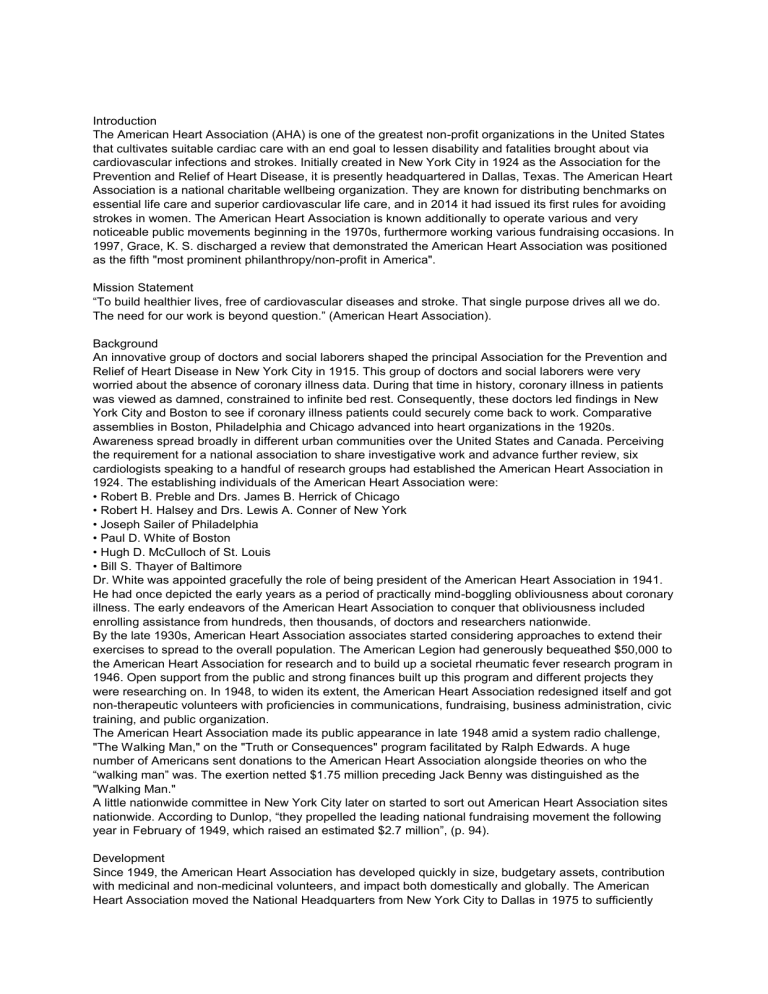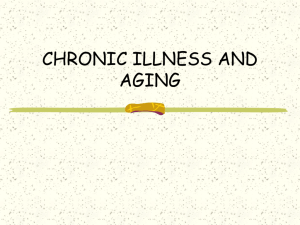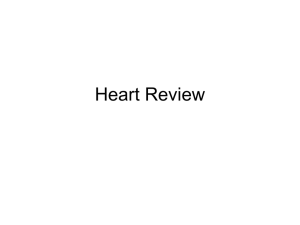
Introduction The American Heart Association (AHA) is one of the greatest non-profit organizations in the United States that cultivates suitable cardiac care with an end goal to lessen disability and fatalities brought about via cardiovascular infections and strokes. Initially created in New York City in 1924 as the Association for the Prevention and Relief of Heart Disease, it is presently headquartered in Dallas, Texas. The American Heart Association is a national charitable wellbeing organization. They are known for distributing benchmarks on essential life care and superior cardiovascular life care, and in 2014 it had issued its first rules for avoiding strokes in women. The American Heart Association is known additionally to operate various and very noticeable public movements beginning in the 1970s, furthermore working various fundraising occasions. In 1997, Grace, K. S. discharged a review that demonstrated the American Heart Association was positioned as the fifth "most prominent philanthropy/non-profit in America". Mission Statement “To build healthier lives, free of cardiovascular diseases and stroke. That single purpose drives all we do. The need for our work is beyond question.” (American Heart Association). Background An innovative group of doctors and social laborers shaped the principal Association for the Prevention and Relief of Heart Disease in New York City in 1915. This group of doctors and social laborers were very worried about the absence of coronary illness data. During that time in history, coronary illness in patients was viewed as damned, constrained to infinite bed rest. Consequently, these doctors led findings in New York City and Boston to see if coronary illness patients could securely come back to work. Comparative assemblies in Boston, Philadelphia and Chicago advanced into heart organizations in the 1920s. Awareness spread broadly in different urban communities over the United States and Canada. Perceiving the requirement for a national association to share investigative work and advance further review, six cardiologists speaking to a handful of research groups had established the American Heart Association in 1924. The establishing individuals of the American Heart Association were: • Robert B. Preble and Drs. James B. Herrick of Chicago • Robert H. Halsey and Drs. Lewis A. Conner of New York • Joseph Sailer of Philadelphia • Paul D. White of Boston • Hugh D. McCulloch of St. Louis • Bill S. Thayer of Baltimore Dr. White was appointed gracefully the role of being president of the American Heart Association in 1941. He had once depicted the early years as a period of practically mind-boggling obliviousness about coronary illness. The early endeavors of the American Heart Association to conquer that obliviousness included enrolling assistance from hundreds, then thousands, of doctors and researchers nationwide. By the late 1930s, American Heart Association associates started considering approaches to extend their exercises to spread to the overall population. The American Legion had generously bequeathed $50,000 to the American Heart Association for research and to build up a societal rheumatic fever research program in 1946. Open support from the public and strong finances built up this program and different projects they were researching on. In 1948, to widen its extent, the American Heart Association redesigned itself and got non-therapeutic volunteers with proficiencies in communications, fundraising, business administration, civic training, and public organization. The American Heart Association made its public appearance in late 1948 amid a system radio challenge, "The Walking Man," on the "Truth or Consequences" program facilitated by Ralph Edwards. A huge number of Americans sent donations to the American Heart Association alongside theories on who the “walking man” was. The exertion netted $1.75 million preceding Jack Benny was distinguished as the "Walking Man." A little nationwide committee in New York City later on started to sort out American Heart Association sites nationwide. According to Dunlop, “they propelled the leading national fundraising movement the following year in February of 1949, which raised an estimated $2.7 million”, (p. 94). Development Since 1949, the American Heart Association has developed quickly in size, budgetary assets, contribution with medicinal and non-medicinal volunteers, and impact both domestically and globally. The American Heart Association moved the National Headquarters from New York City to Dallas in 1975 to sufficiently assist members and nearby divisions across the nation. The volunteer-managed subsidiaries and their divisions shape a national system of easily accessible American Heart Association organizations convoluted in giving examinations, educational classes, and local programs and in raising capital to bolster the affiliation 's efforts. The system keeps on picking up quality as it grows at the minor level. The American Heart Association finished noteworthy inner changes somewhere around 1980 and 1986, permitting it to influence people in general with a louder, clearer voice. Amid the following eight years, the affiliation turned into a substantially more obvious champion of general wellbeing. The American Heart Association likewise created rules for the country 's human services framework and upheld the national government 's endeavor to enhance access to nationwide healthcare services. In the meantime, the American Heart Association kept on reinforcing its core programs and it’s core administration. The organization amended its statement of purpose and centered its arranging in three zones: • Cardiovascular science • Cardiovascular educational classes • Community programs • Fundraising efforts Accomplishments included harsher research norms, innovative healthcare website modules, and advancement of a few cookbooks. Expansive donations permitted the American Heart Association to bolster new research ventures, move all technical staff into one building, and support inventive expert educational programs. In the late 1980’s, endeavors to incorporate more ladies and minorities in the management positions started to pay off, bringing about more endeavors to comprehend the impacts of coronary illness and stroke on ladies and minorities. The mid-1990s were a period of overwhelming change in the American Heart Association. The organizations scientific discoveries started to move all the more rapidly from research facilities and laboratories to doctor 's offices and American homes. The American Heart Association took opinions on critical problems and clarified, straightforward proclamations about controlling hazardous issues. Volunteers and employees conceded to a procedure for enlightening associates into investigative programs, and the national association made new divisions managing strokes and disastrous heart problems. To diminish expenses and increment universal course, the affiliation outsourced the production of its logical diaries and started distributing them on the web. Concepts In spite of the fact that the American Heart Association is a non-profit organization, monetary funds are still generated excessively and a few people are interested on where these funds originate from. In 2007, the American Heart Association was approved a financial plan of $700 million in support of research, group programs, promotion, public, and expert training. As stated by Gaudiani, “the American Heart Association utilized the assets for research on CPR preparing, microsurgery, life-expanding drugs, pacemakers, bypass surgery, and virtual heart valves”, (p. 30). The assets were not utilized of course for the utilization of education and programs. In any case taking after, the American Heart Association had concentrated on conveying a message to society emphatically stressing that individuals ought to: • Quit smoking tobacco products • Control their blood pressure levels • Monitor their diet • Exercise regularly • Sustain a healthful weight The American Heart Association additionally gives training on basic first aid for civilians. As indicated by Burlingame, “the American Heart Association is a non-profitable organization and is a deliberate association financed generally by benefactors”, (p. 183). According to Katel, “the American Heart Association relies on upon more than 3.7 million individuals to help achieve its objectives and have helped raise over $1 billion since 1949”, (p. 1011). The organization makes yearly objectives, assuming on the liability of diminishing coronary illness and strokes. For instance, in 2009, the objective of the American Heart Association was to decrease the unhealthy habit of smoking, lesser high blood pressure and cholesterol in individuals; they diminished it by 25% by mid-2010. The principle duty of the American Heart Association is to distribute the association 's responsibilities into seven key sections while eight fundamentally crucial departments work across the country. Burlingame states, "The seven ranges incorporate the office of the CEO, the promotion division, corporate operations, field operations, field operations, human services market division, science operations and client innovation techniques", (p.184). There are various amounts of stakeholders involved with the American Heart Association. They incorporate but are not limited to: • Volunteers • Employees • Partners • Vendors • Customers These stakeholders have a critical impact in the capacity and everyday operations of the organization. Minus the volunteers and employees, the American Heart Association would discontinue and the American society would not acquire the most recent data on forestalling coronary illness and stroke malady. Minus partners and vendors, the American Heart Association would not have the assets and support to make achievements in further avoiding coronary illness and stroke malady. Minus the customers, the American Heart Association would not have data for their findings and research to discover new drugs or innovations to avoid these unsafe illnesses. Therefore, everybody has an imperative part to the achievement and extension of the American Heart Association. In any case, the American Heart Association has been a noteworthy impact on the lives of people in general both domestically and globally. They have given people in general a superior comprehension of what heart and stroke sicknesses are and the earnestness of these ailments. They likewise have programs and instructive material accessible on what she or he can do as a patient and in addition a supporter to have any kind of effect in his or her life and to avoid from getting these illnesses. They have classes across the nation and universally on the most proficient method to administer CPR and emergency treatment if they may experience somebody who is experiencing a coronary illness or stroke. I for one feel that without the American Heart Association, there would be a high rate of individuals kicking the bucket from these heartbreaking illnesses and individuals would not be able to comprehend what to do on the off chance that they had gone over this malady or counteracted with it. Though through the countless ways the American Heart Association impacts society, there are many ways that society gives back. Since the American Heart Association is a non-profit organization, they can only receive donations and funding through fundraising. I can relate to this amazing organization because being apart of the Fraternity I belong to, we generously hold events where we raise money for the cause. Throughout the academic school year, my Fraternity holds bake sales, talent shows, ‘auctions’, and more to help generate money for donations to the American Heart Association. Another great way I have contributed to this organization is through the Boy Scouts of America. I am an Eagle Scout in the Boy Scouts of America and throughout my training I have been apart of many events where all proceeds went to the association. As a Boy Scout, we have to learn first aid training and when we schedule days to learn the training that is required, we actually contact and receive all of the training and education through the American Heart Association.




